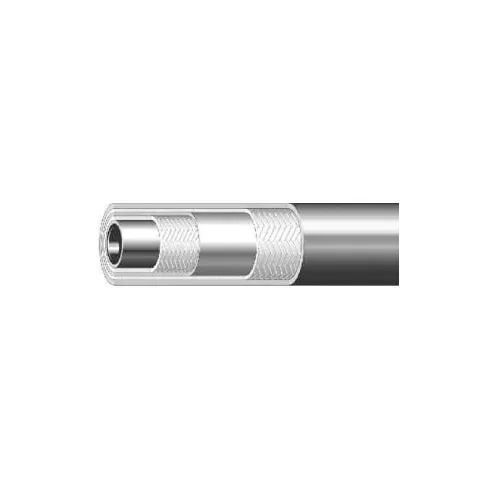What Makes Wire Braid Hose a Preferred Choice for High-Pressure Applications?
2024-11-06
In various industries, the choice of hoses can significantly impact operational efficiency and safety. Among the different types of hoses available, wire braid hoses stand out as a popular option for high-pressure applications. But what is it about wire braid hoses that makes them so desirable? Let’s explore the characteristics, advantages, and applications of wire braid hoses to understand why they are often the go-to choice for demanding environments.
1. How Do Wire Braid Hoses Work?
Wire braid hoses are constructed with a rubber or thermoplastic inner lining that carries the fluid and a braided wire layer that provides reinforcement. This design allows the hose to withstand high pressures and resist external forces. The braided wire typically consists of stainless steel or other durable materials, which helps to enhance the hose's strength and flexibility while maintaining a lightweight profile.
2. What Are the Key Benefits of Using Wire Braid Hose?
One of the most significant advantages of wire braid hoses is their ability to handle high pressures without bursting or leaking. This durability makes them ideal for applications in industries such as oil and gas, automotive, and manufacturing. Additionally, wire braid hoses offer excellent resistance to abrasion and environmental factors, which helps extend their lifespan and reliability.
3. In What Applications Are Wire Braid Hoses Commonly Used?
Wire braid hoses are versatile and can be used in a wide range of applications. They are commonly found in hydraulic systems, where they are used to transport hydraulic fluids at high pressures. These hoses are also used in pneumatic systems, fuel lines, and even in various industrial processes where high-performance fluid transfer is required. Their adaptability makes them suitable for both stationary and mobile equipment.
4. Why Is Flexibility Important in Hose Design?
Flexibility is crucial in hose design, especially in dynamic applications where movement and vibration are common. Wire braid hoses are engineered to provide a balance between strength and flexibility, allowing them to bend and twist without compromising performance. This feature is particularly beneficial in applications where hoses need to navigate around obstacles or connect to equipment with varying orientations.
5. How Do Wire Braid Hoses Compare to Other Hose Types?
When compared to other hose types, such as textile or rubber hoses, wire braid hoses excel in high-pressure situations. While textile hoses may be lighter and more flexible, they often cannot withstand the same pressure levels as wire braid hoses. On the other hand, rubber hoses may be more susceptible to damage from environmental factors. This makes wire braid hoses a preferred choice for applications that demand both high pressure and durability.
6. What Should You Consider When Choosing a Wire Braid Hose?
Selecting the right wire braid hose for your application involves several considerations. Key factors include the hose’s pressure rating, temperature range, and compatibility with the fluids being transported. Additionally, the hose's size and length must be appropriate for the specific application to ensure optimal performance. Consulting with manufacturers or suppliers can help you identify the best hose for your needs.
7. How Can Proper Maintenance Extend the Lifespan of Wire Braid Hoses?
Proper maintenance is essential to maximizing the lifespan and performance of wire braid hoses. Regular inspections for signs of wear, such as cracks or fraying, can help identify potential issues before they become serious problems. Keeping hoses clean and free of contaminants, as well as ensuring proper installation and securing, can also contribute to their longevity. Following manufacturer guidelines for maintenance can further enhance the durability of these hoses.
8. What Innovations Are Influencing Wire Braid Hose Design?
The hose manufacturing industry is continually evolving, with new materials and technologies influencing wire braid hose design. Innovations such as improved rubber compounds, advanced braiding techniques, and coatings that enhance resistance to chemicals and heat are making wire braid hoses even more effective in high-pressure applications. Staying updated on these advancements can help users select the most suitable hoses for their specific needs.
9. How Do Environmental Factors Affect Wire Braid Hose Performance?
Environmental factors, such as temperature fluctuations, exposure to chemicals, and UV radiation, can significantly impact hose performance. Wire braid hoses are designed to withstand various environmental challenges, but it's essential to choose a hose that matches the conditions of your specific application. Understanding the effects of these factors can help users make informed decisions regarding hose selection and application.
10. Why Should You Consider Wire Braid Hoses for Your Operations?
Wire braid hoses offer a unique combination of strength, flexibility, and durability, making them an excellent choice for high-pressure applications. Their versatility across different industries and applications, coupled with their ability to handle demanding conditions, positions them as a reliable option for fluid transfer needs. If you are looking to enhance the safety and efficiency of your operations, wire braid hoses are undoubtedly worth considering.
Conclusion: Are Wire Braid Hoses the Right Solution for Your High-Pressure Needs?
In conclusion, wire braid hoses represent a reliable and efficient choice for high-pressure applications in various industries. Their unique design, combined with the benefits of durability and flexibility, makes them essential for safely transporting fluids in demanding environments. As you evaluate your hose options, consider the advantages of wire braid hoses and how they can support your operational goals.



